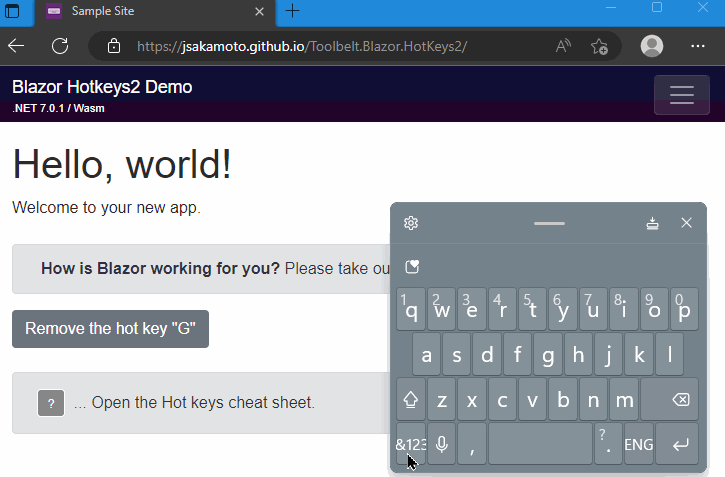This is a class library that provides configuration-centric keyboard shortcuts for your Blazor apps.
(This library is a successor of the "Blazor HotKeys" library.)
You can declare associations of keyboard shortcut and callback action, like this code:
// The method "OnSelectAll" will be invoked
// when the user typed Ctrl+A key combination.
this.HotKeysContext = this.HotKeys.CreateContext()
.Add(ModCode.Ctrl, Code.A, OnSelectAll)
.Add(...)
...;This library suppots ASP.NET Core Blazor version 6.0, 7.0, or later.
Step.1 Install the library via NuGet package, like this.
> dotnet add package Toolbelt.Blazor.HotKeys2Step.2 Register "HotKeys" service into the DI container.
// Program.cs
using Toolbelt.Blazor.Extensions.DependencyInjection; // 👈 1. Add this line
...
builder.Services.AddHotKeys2(); // 👈 2. Add this line
...Step.1 Implement IDisposable interface to the component.
@implements IDisposable @* 👈 Add this at the top of the component. *@
...
@code {
...
public void Dispose() // 👈 Add "Dispose" method.
{
}
}Step.2 Open the Toolbelt.Blazor.HotKeys2 namespace, and inject the HotKeys service into the component.
@implements IDisposable
@using Toolbelt.Blazor.HotKeys2 @* 👈 1. Add this *@
@inject HotKeys HotKeys @* 2. 👈 Add this *@
...Step.3 Invoke CreateContext() method of the HotKeys service instance to create and activate hot keys entries at startup of the component such as OnInitialized() method.
You can add the combination with key and action to the HotKeysContext object that is returned from CreateContext() method, using Add() method.
Please remember that you have to keep the HotKeys Context object in the component field.
@code {
HotKeysContext HotKeysContext;
protected override void OnInitialized()
{
this.HotKeysContext = this.HotKeys.CreateContext()
.Add(ModCode.Ctrl|ModCode.Shift, Code.A, FooBar, "do foo bar.")
.Add(...)
...;
}
void FooBar() // 👈 This will be invoked when Ctrl+Shift+A typed.
{
...
}
}Note
You can also specify the async method to the callback action argument.
Note
The method of the callback action can take an argument which isHotKeyEntryByCodeorHotKeyEntryByKeyobject.
Step.4 Dispose the HotKeysContext object when the component is disposing, in the Dispose() method of the component.
@code {
...
public void Dispose()
{
this.HotKeysContext.Dispose(); // 👈 1. Add this
}
}The complete source code (.razor) of this component is bellow.
@page "/"
@implements IDisposable
@using Toolbelt.Blazor.HotKeys2
@inject HotKeys HotKeys
@code {
HotKeysContext HotKeysContext;
protected override void OnInitialized()
{
this.HotKeysContext = this.HotKeys.CreateContext()
.Add(ModCode.Ctrl|ModCode.Shift, Code.A, FooBar, "do foo bar.")
}
void FooBar()
{
// Do something here.
}
public void Dispose()
{
this.HotKeysContext.Dispose();
}
}You can specify enabling/disabling hotkeys depending on which kind of element has focus at the hotkeys registration via a combination of the Exclude flags in optional arguments of the HotKeysContext.Add() method.
By default, the Exclude flags argument is the following combination.
Exclude.InputText | Exclude.InputNonText | Exclude.TextAreaThis means, by default, hotkeys are disabled when the focus is in <input> (with any type) or <textarea> elements.
If you want to enable hotkeys even when an <input type="text"/> has focus, you can do it as below.
... this.HotKeys.CreateContext()
.Add(Code.A, OnKeyDownA, "...",
// 👇 Specify the "exclude" argument.
exclude: Exclude.InputNonText | Exclude.TextArea)
...And you can specify the Exclude.ContentEditable to register the unavailable hotkey when any "contenteditable" applied elements have focus.
There are two ways to register hotkeys in the HotKeysContext.
One of them is registration by the Code class, and another one is registration by the Key class.
Hotkeys registration by the Code class is based on the physical location of keys.
For example, if you register a hotkey by Add(ModCodes.Shift, Code.A, callback), the callback will be invoked when a user presses the "Shift" and the "A" keys. In this case, that hotkey doesn't depend on the Caps Lock key condition. Regardless of whether the Caps Lock key is on or off, the callback will be invoked whenever a user press the "Shift + A". This means the hotkey registered by the Code class works based on the location of the pressed key. It is no matter what character will be inputted, both "a" lower case and "A" upper case, as long as the key printed "A" on its key top is pressed.
I recommend using the Code class for hotkeys registration in the following cases.
- The hotkeys are based on alphabetical or numerical keytops.
- The hotkeys are based on the difference of left or right of the Shift, Control, Alt, and Meta keys.
- The hotkeys are based on a combination with the Shift key.
Hotkeys registration by the Key class is based on the character inputted by key pressing.
For example, if you register a hotkey by Add(Key.Question, callback), the callback will be invoked when a user presses a key combination that will input the ? character. In this case, that hotkey doesn't depend on the physical layout of the keys. Generally, the ? character will be inputted by pressing the "Shift+/" on a US layout keyboard. But, on a Czech Republic layout keyboard, the ? character will be inputted by pressing the "Shift+,". Therefore, you should not register the hotkey for the ? by the Code class based on physical key locations, like Add(ModCodes.Shift, Code.Slash, ...).
In addition, the combination with the Shift key can not use on the registration hotkeys by the Key class. This is a limitation for the hotkeys to be independent on physical keyboard layout.
I recommend using the Key class for hotkeys registration in the following cases.
- The hotkeys are based on symbols, such as
?,@,#, etc. - The hotkeys don't mind whether the Shift key is pressed or not.
Unlike "angular-hotkeys", this library doesn't provide "cheat sheet" feature, at this time.
Instead, the HotKeysContext object provides Keys property, so you can implement your own "Cheat Sheet" UI, like this code:
<ul>
@foreach (var key in this.HotKeysContext.Keys)
{
<li>@key</li>
}
</ul>The rendering result:
- Shift+Ctrl+A: do foo bar.
- ...

